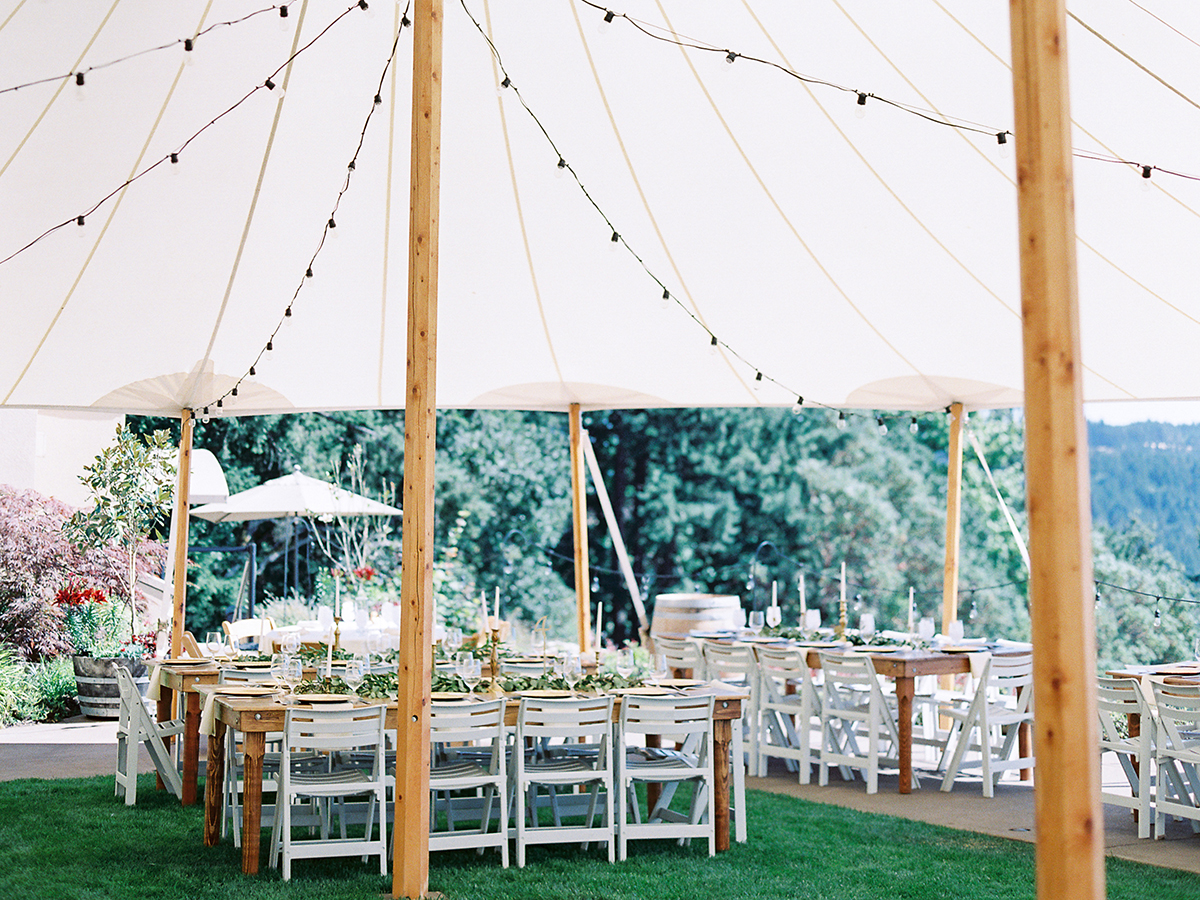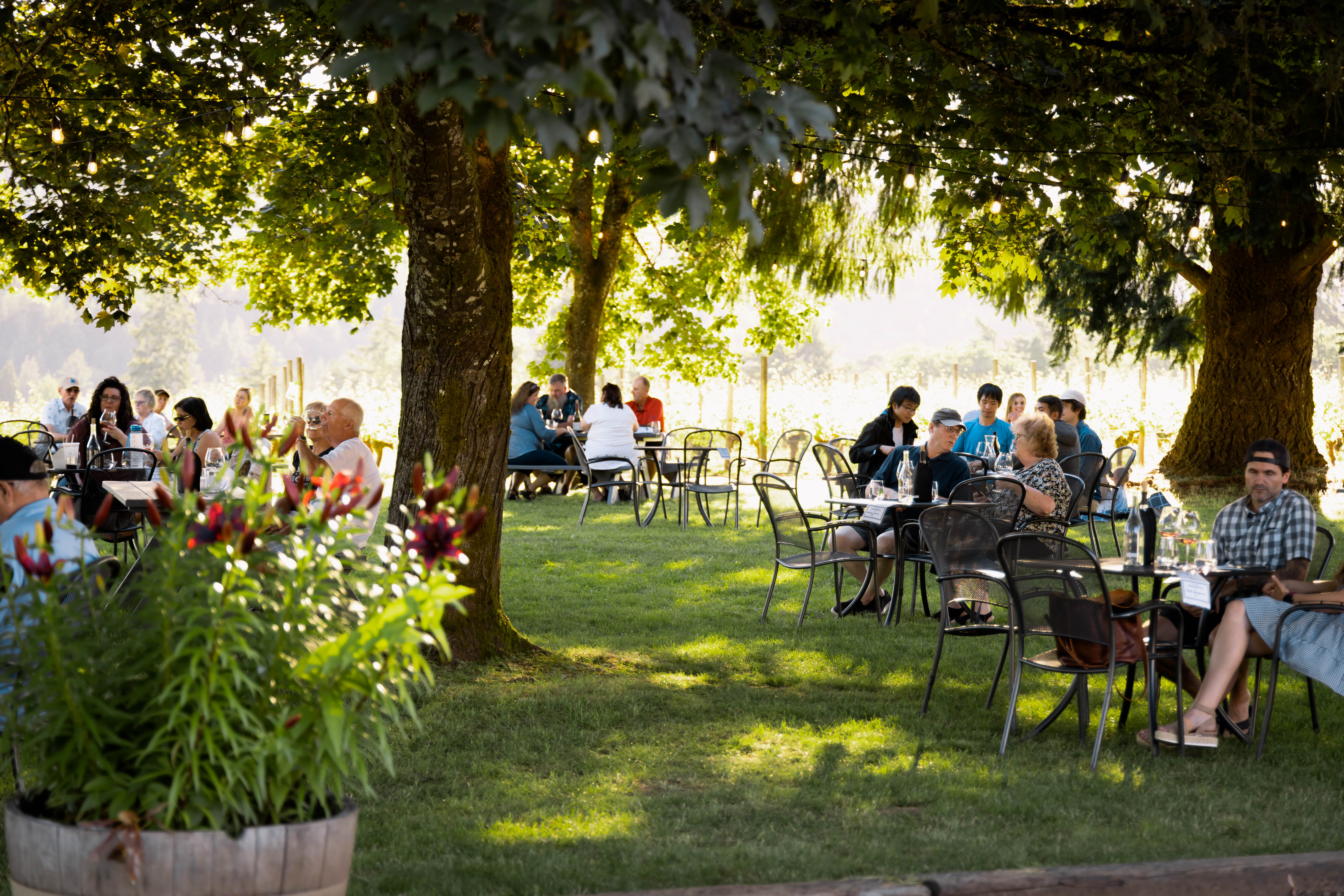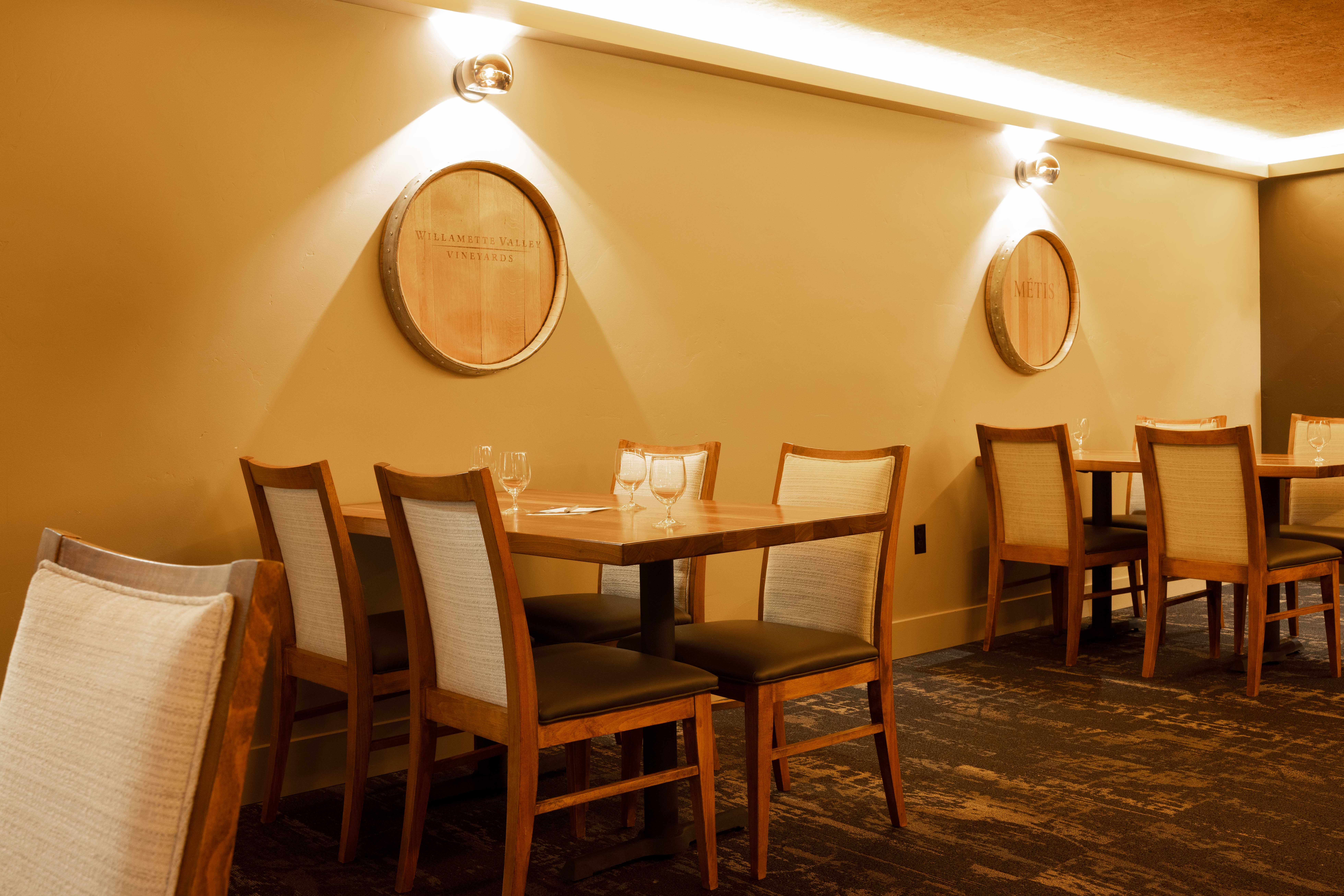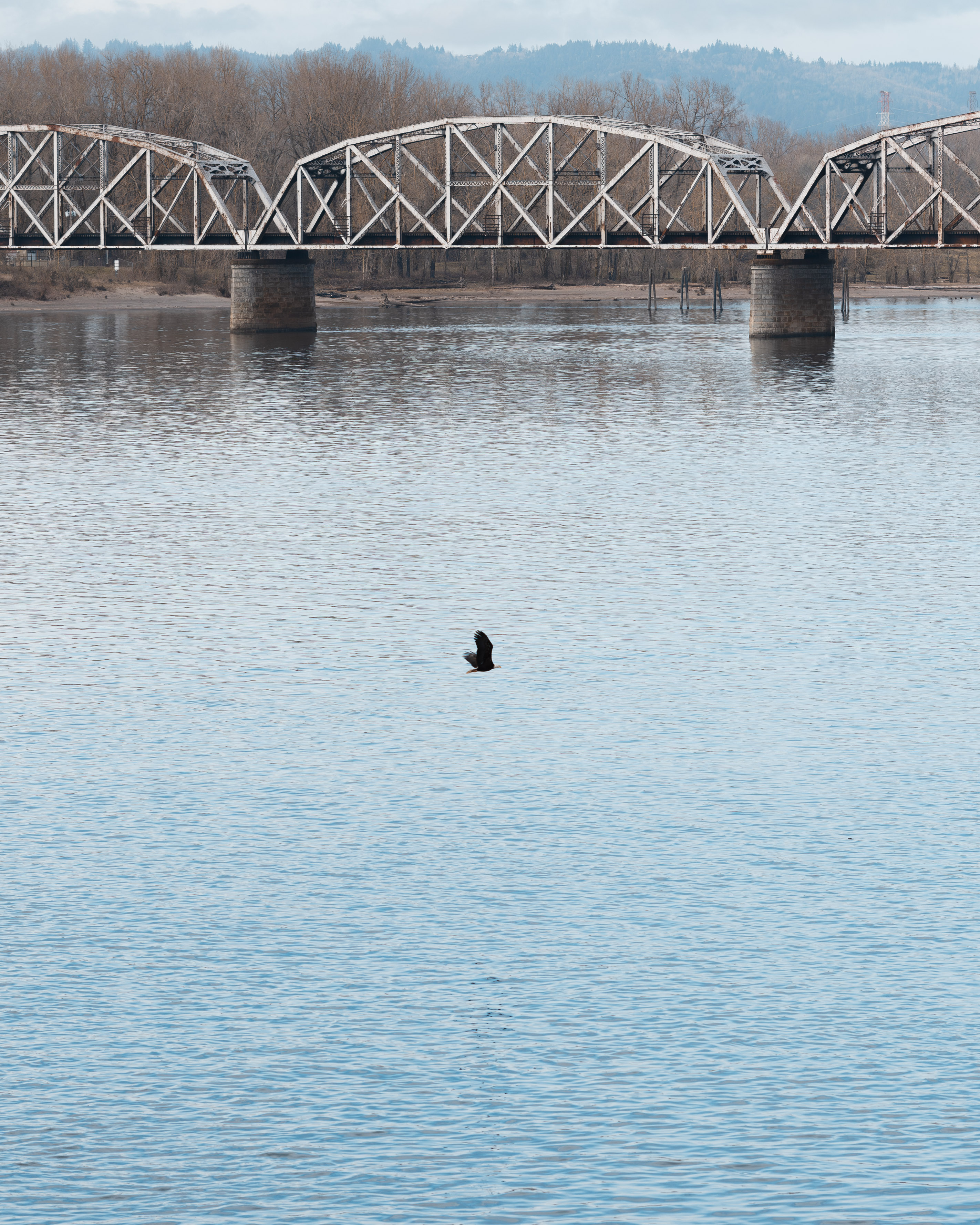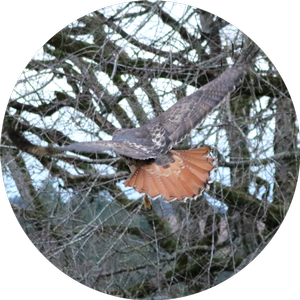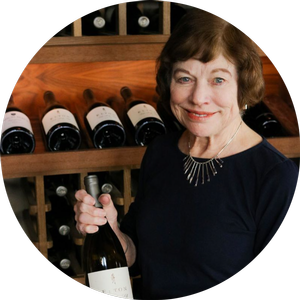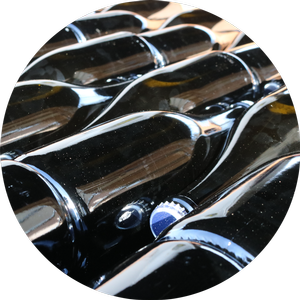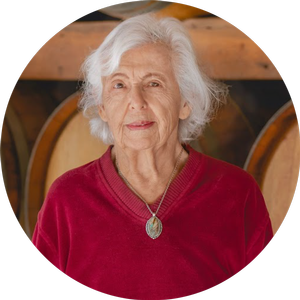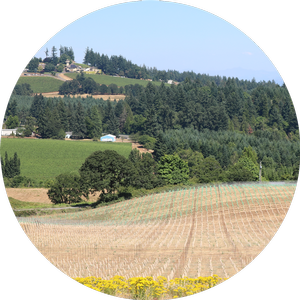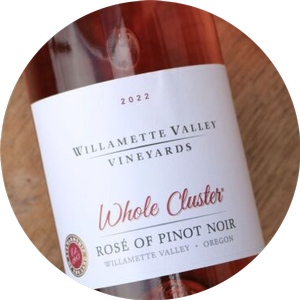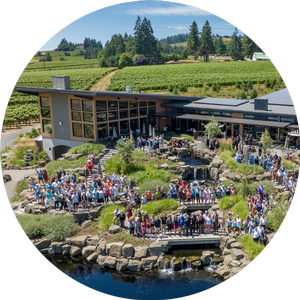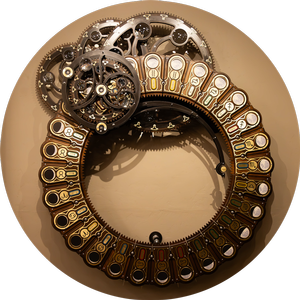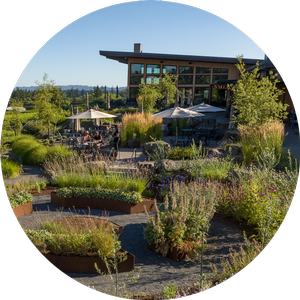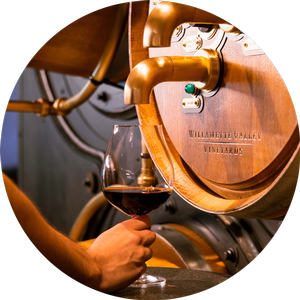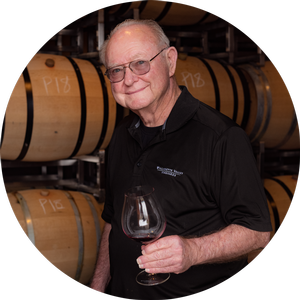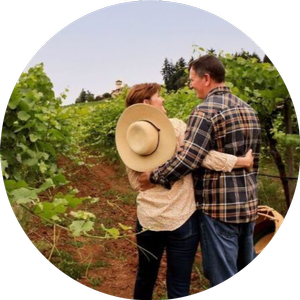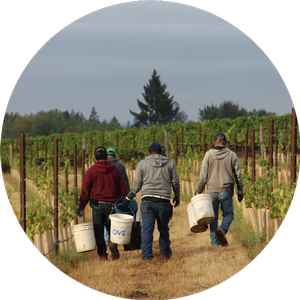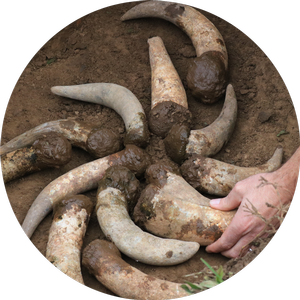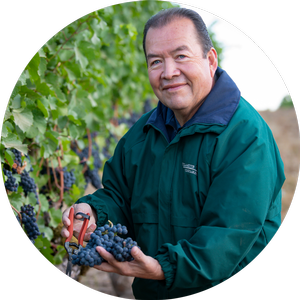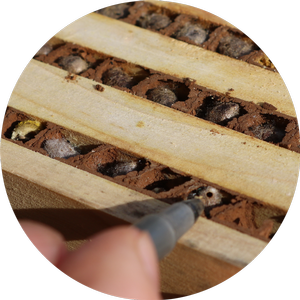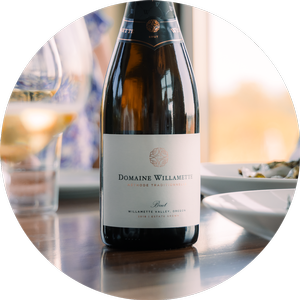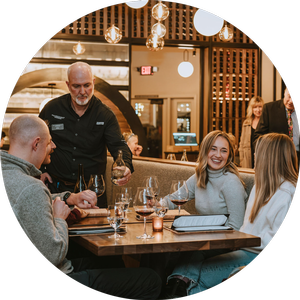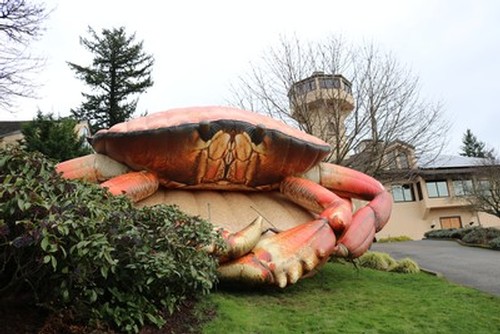Host Your Next Event at a Winery or Tasting Room
Willamette Valley Vineyards is the perfect place to host your next social gathering. Whether you’re looking for a quiet, private room or a space with stunning views, our wineries and tasting rooms are here to make your next event fun and memorable.
Willamette offers a variety of settings for your event, from a casual bartop or an elevated pairings experience for intimate gatherings to private rooms and outdoor spaces for grander occasions.
Large Events
The Estate in the Salem Hills is ideal for hosting larger gatherings such as company retreats, holiday parties and family reunions.
Venues at the Estate include private rooms, outdoor patios, lawn spaces and more. Depending on the location, the estate can accommodate 8 to 150 guests. A private pairings dinner experience is also available, with Willamette handling all your wine and food needs.
The Estate in the Salem Hills features a variety of indoor and outdoor spaces for hosting private events.
“You get the chance to engage with knowledgeable wine staff, learn about the wine and see the beautiful winery,” said Kaylin Ray, the Estate’s Hospitality and Guest Experience Manager.
Tualatin Estate Vineyard is another option for large groups. This historic venue offers guests beautiful views and a great outdoor space for hosting. Holding an event at one of Oregon’s oldest and most respected vineyards will make your gathering memorable.
Tualatin Estate Vineyard is the perfect place to host an outdoor summer event.
Tualatin Estate Vineyard can accommodate 25 guests inside and 100 outside during summer. The vineyard does not provide food, but guests are welcome to bring in small bites or work with a local caterer or restaurant.
Sparkling winery Domaine Willamette offers a wide selection of private event options in the Dundee Hills.
Choose from indoor or outdoor spaces and host a small group or rent out the Tasting Room for a larger gathering.
Private Rooms
If you’re planning a small or medium-sized gathering, our Tasting Room & Restaurants are great places to celebrate.
The Happy Valley, Lake Oswego and Bend locations all feature private wine rooms that can accommodate between 24 and 44 guests depending on the venue.
The private rooms offer guests a secluded space, perfect for business meetings, small family celebrations and more.
“It’s fun, it’s intimate, it’s a really good location and friendly environment and we have a knowledgeable team,” said Bend Tasting Room General Manager Cara Doering
The Bend Tasting Room & Restaurant can host fun, intimate gatherings in its private wine room.
Doering added that guests can also reserve the entire Tasting Room for larger events.
Another option for a private event is renting out the McMinnville Tasting Room after regular business hours.
The McMinnville Tasting Room accommodates a minimum of 12 guests and a maximum of 40. This Tasting Room does not offer food, but guests are welcome to bring in small bites or work with a local caterer or restaurant.
Beautiful Views
Many Willamette locations offer stunning views that will make your event memorable.
The Vancouver Tasting Room & Restaurant features beautiful views of the Columbia River.
The Vancouver Tasting Room features picturesque views of the Columbia River. This location offers various semi-private event options including casual bar service with appetizers and a multi-course seated dinner.
“We are extremely flexible. The template is just a place to start,” Vancouver Tasting Room Lead Linde Brown said. “It’s easy for us to cater to individual needs.”
Anyone considering hosting a private event at one of Willamette’s locations can reach out to the individual locations through a contact form to learn about food and wine minimums, deposits, pricing and other details. Advance notice is appreciated at all locations.
Mason Bees Return to Willamette Valley Vineyards
When the vineyard wakes up with new growth and buds on the vines, we know it’s time to welcome back our mason bees.
In March, Stephen Paisley, Willamette’s “Bee Guy,” and Randy Hillyer, the winery’s Facilities Coordinator, put thousands of mason bee cocoons back into bee houses at Elton Vineyard, Tualatin Estate Vineyard, Bernau Estate Vineyard and the Estate in the Salem Hills.
It was time to reintroduce the bees to the environment because mason bees begin to wake up and emerge from their cocoons when temperatures consistently reach 55 degrees Fahrenheit and above.
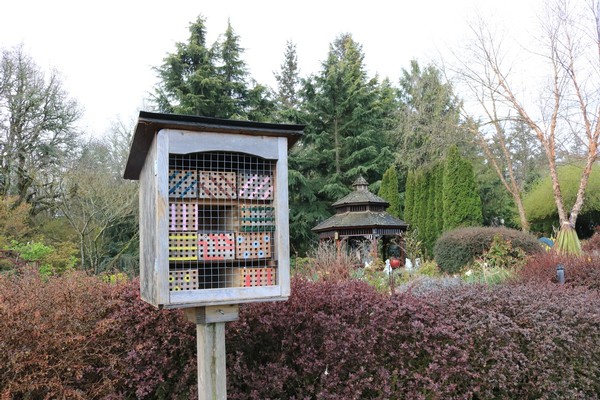 Mason bees do incredibly well at Elton Vineyard due to the surrounding garden.
Mason bees do incredibly well at Elton Vineyard due to the surrounding garden.In November, Stephen and Randy cleaned the bee cocoons, which were then stored in a refrigerator. Cleaning the cocoons and bee box trays is an important part of maintaining mason bee populations because it removes pests, mold, pollen, wasps, and other materials from the trays and provides the bees with a clean and safe place to live and lay eggs.
Now that the cocoons are back in the bee houses, the bees will start to wake up. Thankfully, a little wet weather won’t prevent these efficient pollinators from doing what they do best.
“They’re true Oregonians,” Stephen said. “Unlike honey bees, they work in the rain.”
Sustainable Stewardship
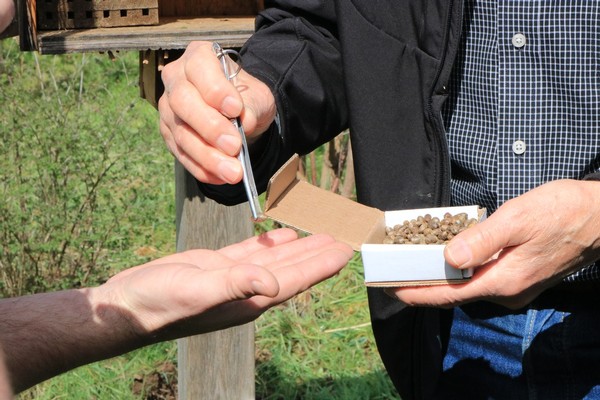 Stephen Paisley displays a mason bee cocoon.
Stephen Paisley displays a mason bee cocoon.Managing mason bees is one way Willamette encourages stewardship of the land. Our vines are self-pollinating, so the bees don’t directly impact our crop. However, mason bees are extremely efficient pollinators, making them crucial to farms and gardens everywhere.
Guests who want to see the mason bees in action will have the perfect opportunity this month at our Estate in the Salem Hills or at Domaine Willamette in the Dundee Hills.
Celebrate Earth Day with Stephen at the Estate on Saturday, April 20th or Sunday, April 21st for a Mason Bee Tour & Tasting that includes a tasting of select wines and a honey-themed cheese plate.
The Oregon Bee Project will lead a Mason Bees in the Garden Tour & Tasting through our biodynamic garden at Domaine Willamette on Saturday, April 27th. You’ll enjoy a flight of four wines paired with small bites.
Willamette Valley Vineyards Releases Three New Alsatian Wines
It’s a full-circle moment for Terry Culton, Willamette’s Director of Winemaking & Vineyards.
When Terry was our Cellar Master in 1998, we made a small lot of Dry Riesling from Tualatin Estate Vineyard. Terry said that at the time, some Portland restaurateurs raved about how much the wine tasted like that of the Alsatian region in Europe.
When Terry returned to Willamette in 2022, he knew he wanted to resurrect the wine and bring the past into the present.
“We’re excited about it. It’s really fun to make it again,” Terry said. “When Jim asked me to come back, I asked if I could make the Dry Riesling.”
The 2022 Dry Riesling was hand-picked from Riesling vines that date back to Tualatin Estate Founder Bill Fuller’s 1973 planting. It is one of three Alsatian wines Willamette is releasing as a three-pack this April. The other two featured wines are the 2022 Dry Gewürztraminer and 2022 Auxerrois.
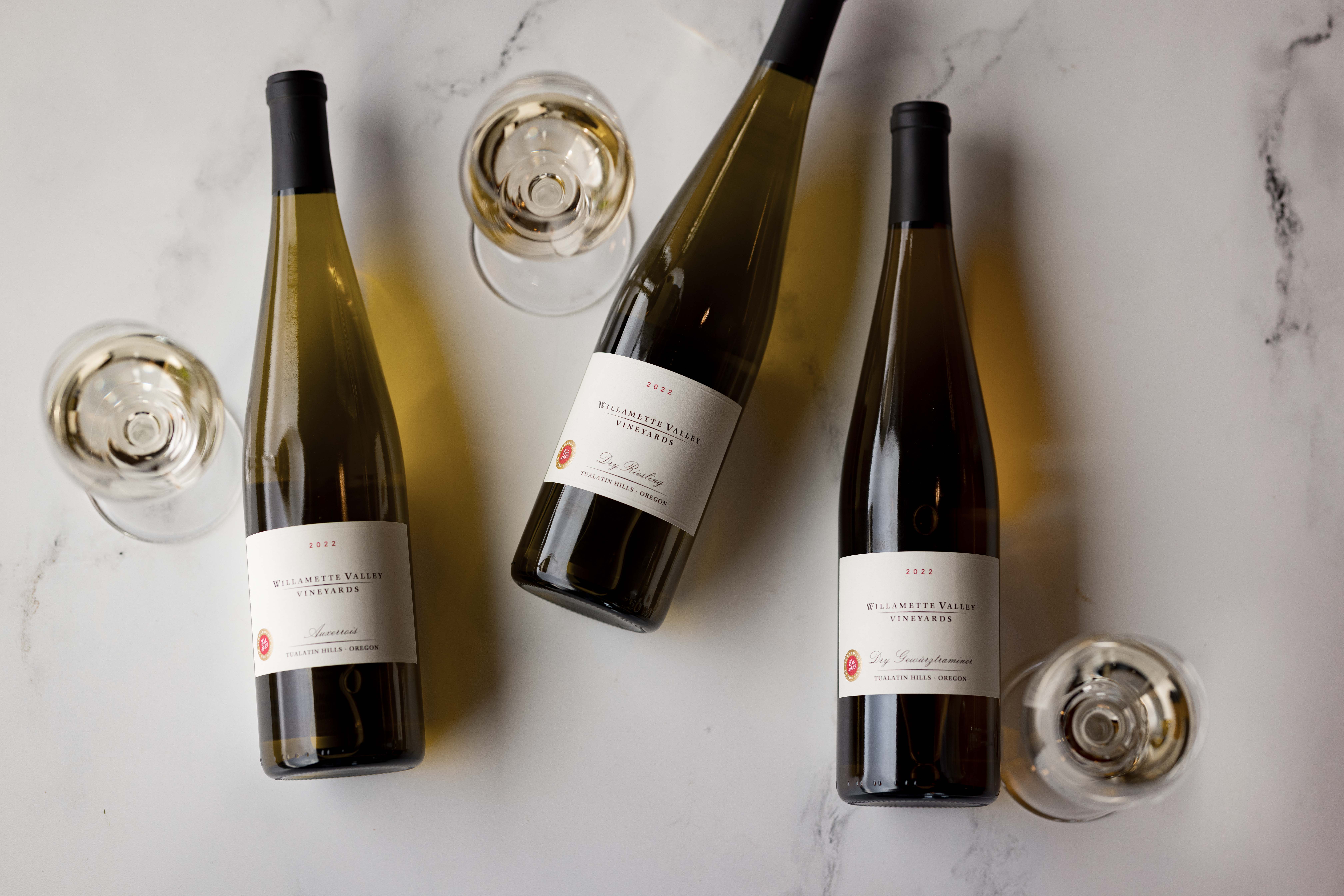 Enjoy Willamette's Alsatian Trio, featuring our Dry Riesling, Dry Gewürztraminer and Auxerrois.
Enjoy Willamette's Alsatian Trio, featuring our Dry Riesling, Dry Gewürztraminer and Auxerrois.
The Alsace region borders France and Germany and features a cooler climate. This region is known for cold, aromatic whites like the German varietals Riesling and French varietals Gewürztraminer, Auxerrois and Pinot Blanc.
“One of the prettiest white wines I’ve ever had was an Alsatian wine,” Terry said. “I like the dryer style and you get a little bit more weight and richer mouthfeel. I love that region.”
Bill Fuller’s Gewürztraminer
In 1973, Bill Fuller planted Gewürztraminer grape vines which produced highly-rated wines. Willamette’s 2022 Dry Gewürztraminer is a celebration of Bill’s dedication to the Tualatin Estate Vineyard and the Oregon wine industry.
To make the 2022 Dry Gewürztraminer, we used Bill’s traditional method that he pioneered over the years. We destemmed 50% of the grapes and let them soak on their skins before combining these with the other 50% which was left whole cluster.
This wine pairs well with spicy and aromatic cuisines like Asian and Thai and dishes like barbecue wings and grilled pork chops.
Auxerrois
Wine enthusiasts can try one more traditional Alsatian varietal from Willamette this spring. The Auxerrois is a style of wine fully related to Chardonnay and often blended with Pinot Blanc. Traditionally, it is a rich and complex wine, with lush fruit and crisp acidity. Willamette has never made an Auxerrois.
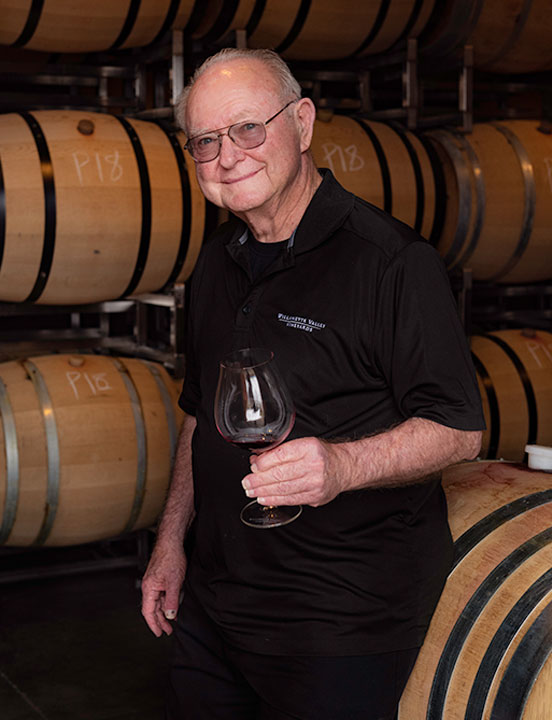 Bill Fuller, Founder of Tualatin Estate Vineyard and Consulting Winemaker
Bill Fuller, Founder of Tualatin Estate Vineyard and Consulting Winemaker
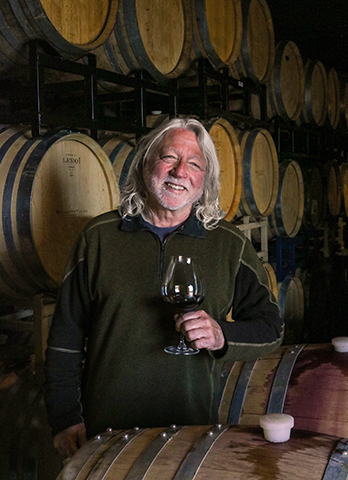 Terry Culton, Willamette's Director of Winemaking & Vineyards
Terry Culton, Willamette's Director of Winemaking & Vineyards
Usually blended into other wines, Terry wanted to highlight this Alsatian varietal as a stand-alone wine.
“I liked it so much on its own that I really pushed to have it done as its own varietal,” Terry said. “I got a lot of pushback from everyone.”
After tasting the wine, Terry said everyone changed their minds.
The grapes were hand-picked from Tualatin Estate Vineyard vines planted in 2006 and were whole-cluster pressed to neutral French Oak barrels.
“I’m excited about releasing the wines in a 3-pack so everyone can try all of them and see the similarities and differences and what makes them all unique in their own character,” Terry said. “They’re all food-friendly wines, crisp and fresh.”
The Dry Riesling was included in February’s Founders’ Wine Club, a club exclusive to Willamette’s shareholders. The Dry Guwürztraminer and Dry Auxerrois are exclusive for Club Members to purchase and will be available in April.
Wine critic Owen Bargreen rated all three Alsatian wines 91 points.
Next week, all three wines will be released to the general public in limited quantities and for a limited time. Please check your Willamette emails for the release.
At Work in the Winter
Winter in the vineyard doesn’t mean our crews take a break until spring — and the vines don’t either.
It may look like little is happening during the dormancy phase, but beneath the surface, the vines have been working hard to tolerate and acclimate to the cold days of winter.
After harvest, the vines’ roots begin to grow, soaking up nutrients from the soil.
And although cold temperatures can harm crops, grape vines are extremely resilient. Water and nutrients in the vines move into the trunk and roots when temperatures drop. Storing these carbohydrates helps prevent the freezing of the plant tissue and gives the vines the energy they need for bud break come spring.
While the vines do a lot of self-maintenance, pruning is an important part of the grape-growing process that helps prepare the vines for future fruit development.
During the colder months, our vineyard stewards are hard at work pruning and maintaining the dormant vines. This week, they finished pruning vines at our Estate in the Salem Hills and are anticipating bud break.
Pruning and Preparations
Vineyard Manager Efren Loeza started working at Tualatin Estate Vineyard as a teenager and eventually joined Willamette’s team when it merged with Tualatin Estate in 1997.
Efren learned about vineyard management and specifically pruning from pioneering viticulturist David Foster. He brought that knowledge to our multiple vineyards spanning more than 500 acres.
Pruning is a crucial component of vine management as the decisions our vineyard stewards make when pruning will impact the next year’s growth.
At Willamette, we utilize different styles of trellises to maximize quality grape growth. This paired with intentional pruning and maintenance decisions gives us plentiful harvests.
Watch the video below featuring Efren and Founder & CEO Jim Bernau to learn more about vine maintenance.
Women in Wine: Meet Alexis, Willamette’s Enologist
Winemaking is a science and an art. That unusual combination led Willamette’s Enologist Alexis Doyle Langer to pursue a career in winemaking.
“What is fascinating about winemaking is that you let the analysis guide you, but you still rely on sensory input to make decisions,” Alexis said. “I can make a wine analytically perfect, but if the consumers don’t like it, it doesn’t matter. It’s a science and an art at the same time.”
Alexis is one of Willamette’s many women working in wine. March 25th, National Women in Wine Day, is a time to acknowledge Alexis and all of the incredible women who make up our winery’s busy staff.
Learning the ropes
Alexis dreamed of being a distiller in Scotland. She attended Oregon State University to study food science and, through that program, ended up working in the wine lab. At that point, she fell in love with the art and science of winemaking.
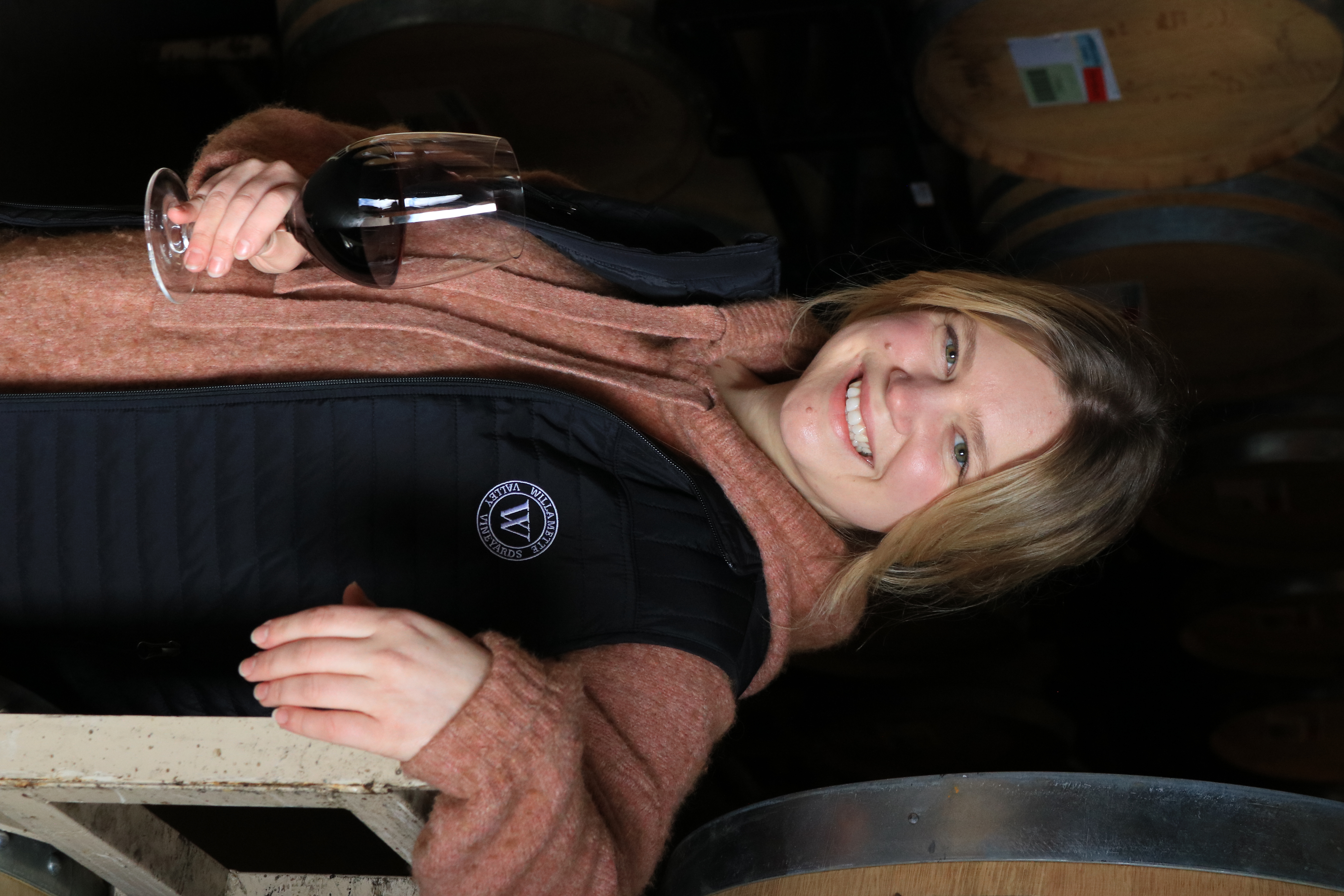 Alexis Doyle Langer, Willamette's Enologist
Alexis Doyle Langer, Willamette's EnologistWhile in school, she worked at Bluebird Hill Cellar in Monroe and helped with everything from vineyard management to cellar work to the tasting room.
“It was a good opportunity to see all sides of the winemaking process,” Alexis said.
Following graduation, she worked a harvest in California and returned to Oregon, where she took a job as a lab technician at Willamette.
Alexis quickly moved up in the company and became lab manager and later our enologist.
“I was tenacious and saw where there were needs and filled them,” she said. “I really grew into the position.”
A year into her work as our enologist, Alexis is excited about what each day brings.
“Winemaking is tough work,” she said. “But I still wake up excited to do my job. I’m very passionate about wine, educating others and furthering my understanding. I like that there are new challenges every day.”
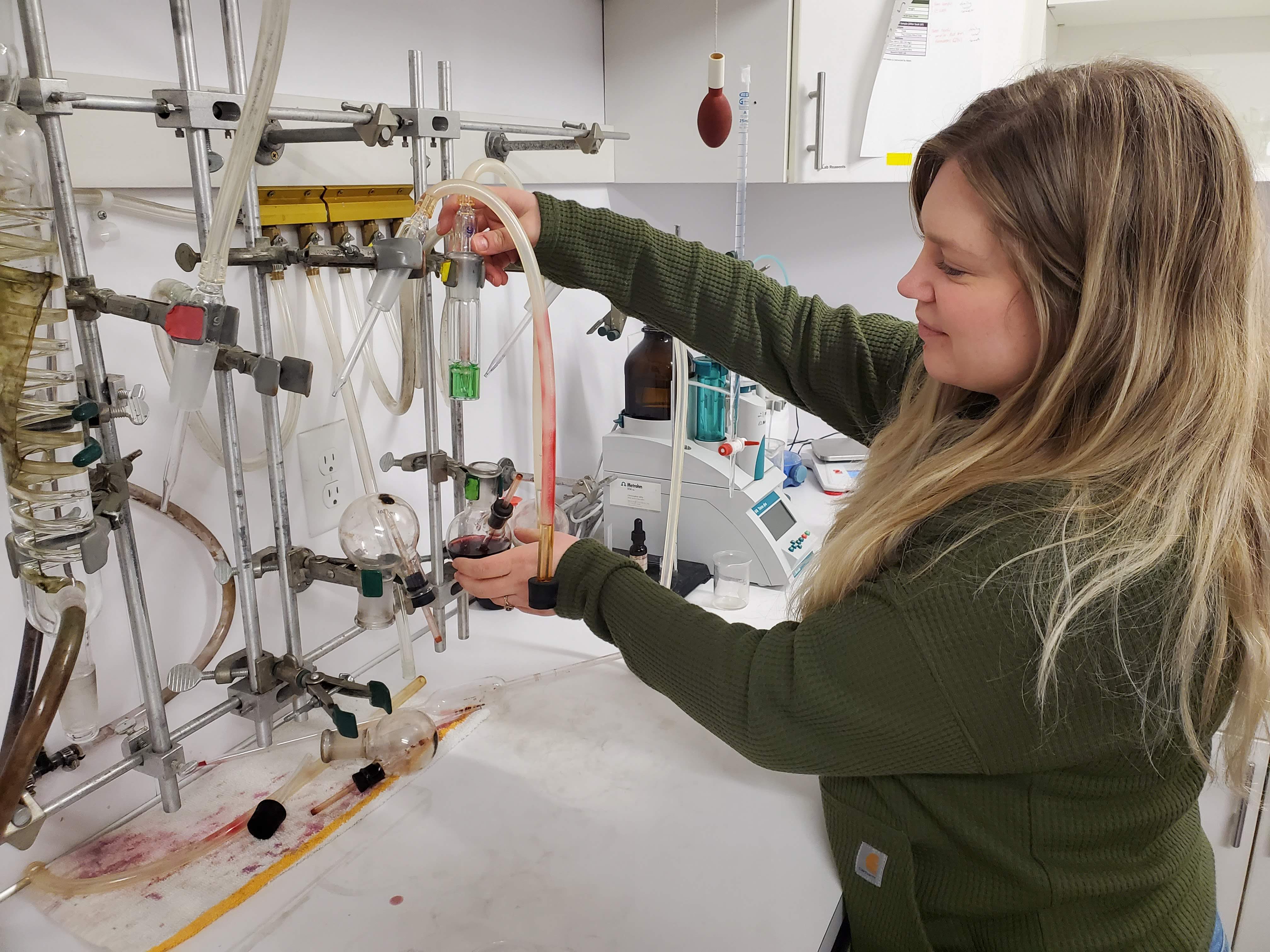 Alexis started at Willamette as a lab technician and quickly worked her way through the ranks.
Alexis started at Willamette as a lab technician and quickly worked her way through the ranks.Supporting each other
Alexis said she was fortunate enough to have many women who helped her achieve her goals.
It started with her mom. Alexis said her mom encouraged her to be hardworking, driven and passionate and taught her that success meant trying your best. These qualities helped her quickly climb the ranks at Willamette.
Through Oregon nonprofit Women in Wine, Alexis met Emily Terrell, Associate Winemaker at Brittan Vineyards. Emily became a mentor to her. Having a fellow woman winemaker show her the ropes inspired Alexis and helped her gain a better understanding of the wine industry.
Now, it’s her turn to be a mentor to others.
“I’m in a position where I get to help foster those relationships, open doors for women and guide them in the wine industry,” she said.
Lifting other women up is something Alexis believes is an essential part of being a woman in wine. She said encouraging and supporting other women, especially helping them overcome self-doubt, is crucial.
“Building that diversity and understanding where people are coming from will advance winemaking for future generations,” she said.
About Willamette’s Women in Wine
At Willamette Valley Vineyards, we celebrate and support women in the wine industry to inspire change. Roughly 58.2% of our staff and 56% of our leadership team are composed of passionate women dedicated to shaping the Oregon wine industry. Willamette's female staff is also some of its most tenured; 44% of our employees with 5 or more years at the company are women.
This year, celebrate National Women in Wine Day by enjoying a limited collection curated by some of our female leaders, including Alexis.
 Willamette's Women in Wine
Willamette's Women in WineCraft Your Own Wine with a Blending Experience at Willamette Valley Vineyards
Try your hands at crafting your perfect wine during a red blending experience at Willamette Valley Vineyards.
Blending experiences are available at the Estate in the Salem Hills, Willamette Wineworks in Folsom, California, and our Vancouver Tasting Room & Restaurant. These venues offer guests a unique opportunity to learn about wine and take control of the winemaking process.
“It breaks it down to a personal experience,” Vancouver Winery Ambassador Julian LaRocca said. “People get to feel a connection to what they’re doing.”
The prototype for the blending system was created and installed at Willamette Wineworks and later modified for the other locations by David Markel, Willamette Valley Vineyards Research and Development Manager.
Each location is slightly different, with regional varietals available for blending a unique cuvée. At the Estate in the Salem Hills, wine enthusiasts can learn about and taste seven different Pinot Noir clones. At Willamette Wineworks, guests blend Natoma wines made in California.
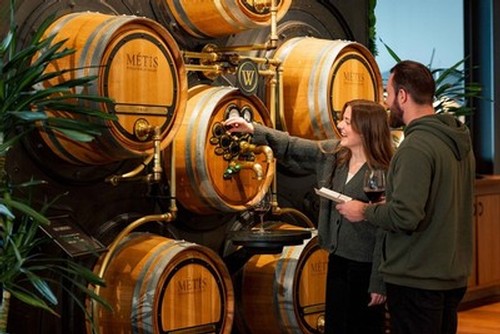
In Vancouver, guests blend 5 Walla Walla AVA wines.
The blending system in Vancouver is the newest of the three, debuting in 2023. This location features five varietals grown on the Oregon side of the Walla Walla AVA. Guests can create their blend using Merlot, Cabernet Franc, Malbec, Syrah and Cabernet Sauvignon.
“The Blending System elevates the Tasting Room to be more of a complete experience,” Julian said. “It brings you closer to the wine and makes this more than just a restaurant.”
The Experience
A Winery Ambassador leads participants in learning about each varietal, sharing stories about the different grapes and where they grow.
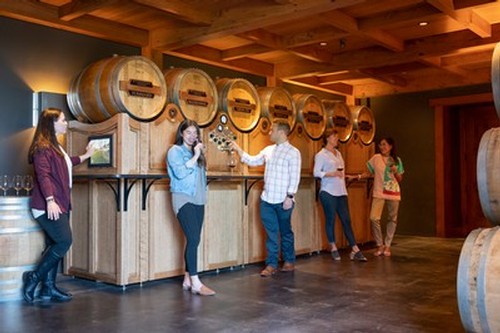
At the Estate in the Salem Hills, guests can create their perfect blend using seven different Pinot Noir clones.
Attendees taste each wine, noting what flavors and aromas they experience. Next, guests create their ideal blend using the dials on the blending system to determine how much of each varietal they want in their wine.
Julian said there are no rules, but he suggests not trying to blend an equal amount of each varietal. He added that the group activity can be fun, competitive and memorable.
“A huge part of wine is the group aspect,” Julian said. “It’s about community.”
Winery Ambassadors take note of each participant’s blend so they can purchase a carafe or glass of their blend any time they visit the Vancouver location.
Guests who try out the blending experience at the Estate can purchase a carafe of their blend and take home a bottle of their creation. At Willamette Wineworks, participants can purchase a glass or growler of their favorite blend.
Celebrate Washington Wine Month with a Blending
Those looking to pair their blending experience with a special evening can reserve a spot at our Washington Wine Month Celebration and Métis release party in Vancouver on Sunday, March 24th, at 5 pm.
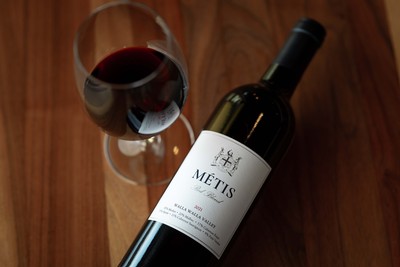
Before crafting your blend, you’ll taste our newly released 2021 Métis Red Blend. Tickets are $55 per person or $50 for Wine Club Members and $45 for Owners.
Julian said his favorite part is watching attendees take ownership of their wine.
“It’s special seeing people share their blend with friends,” he said. “The people that made the wine get to explain it as they share it.”
Join Willamette Valley Vineyards in a Celebration of Oregon Truffles
Throughout February, wine enthusiasts are invited to celebrate Oregon truffles with Willamette Valley Vineyards.
Willamette’s Tasting Room & Restaurants locations in Lake Oswego, Vancouver, Happy Valley and Bend will feature truffle add-ons throughout the month, and the Estate in the Salem Hills is hosting a Gala Truffle Dinner as a part of the Oregon Truffle Festival (OTF). Tickets for the dinner are sold out, but guests can find a waitlist here.
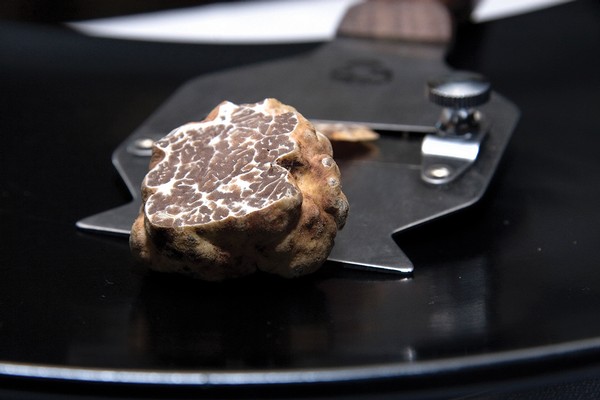
The OTF is a nonprofit that seeks to educate the community and grow the Oregon truffle industry.
With the truffle harvesting season running through the rainier months, February is the traditional time to celebrate these delicacies.
What makes truffles special
For Executive Winery Chef DJ MacIntyre, though, truffles should be celebrated all year.
“One of the reasons I came down to Oregon was for truffles,” said DJ, who graduated from the University of Oregon and worked for Chef John Howie in Seattle before joining Willamette’s team in 2015. “I love mushrooms in general, and truffles take on a whole new realm of what they can do.”
Oregon is home to a variety of truffles that are equal in quality to their European counterparts, he said. Varieties of Oregon truffles include winter white, spring white, black and brown.
“There is a high quality of truffles the majority of the year, which allows chefs in the area to play with the flavors and Northwest ingredients,” DJ said. He added that the complexity of the taste and smell of truffles makes them extremely versatile.
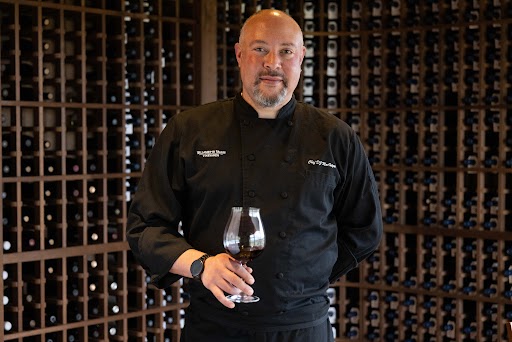
Executive Winery Chef DJ MacIntyre
Pairing truffles and wine
Cooking with truffles can be as simple as sprinkling fries with truffle oil or as complicated as infusing eggs and cream for a decadent carbonara. Ingredients with a fat or oil base will pick up the aromas and flavors of truffles well.
Dishes featuring truffles pair perfectly with Willamette wines. For example, the earthiness in some truffles lends itself well to pairing with our Pinot Noirs.
“‘If it grows together, it goes together,’” DJ said, quoting a principle of wine and food pairings. Because of this, truffles can pair well with many Pacific Northwest ingredients.
When pairing a truffle dish with wine, DJ said it's important to consider the different flavors and qualities of the wine.
Oregon white truffles have more of a funky, garlicky taste, while black truffles are a little bit on the sweeter side. So a dessert featuring the sweeter, fruitier notes of a black truffle pairs well with our Domaine Willamette Brut Rosé and its strawberry and honeydew with citrus notes. Meanwhile, a white truffle-infused meat dish with more garlicky flavor would pair well with an earthy Pinot Noir.
The Oregon Truffle Industry
Willamette’s interest in the Oregon truffle industry goes beyond wine and food pairings.
“We're trying to build awareness that we have something that is a unique food product that comes from Oregon,” DJ said.
Oregon truffles grow naturally beneath Douglas fir trees. Hazelnut farmers can now innoculate their trees with truffles, an advancement in farming technology that could give them a secondary crop from their orchards and help increase the availability of Oregon truffles.
To help showcase the connection between wine and food, the root systems of cork oak trees planted at sparkling winery Domaine Willamette are inoculated to grow French black truffles.
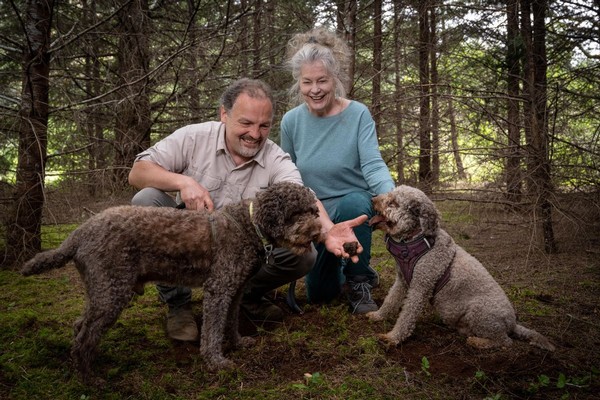
Oregon Truffle Festival Founders Charles Lefevre and Leslie Scott with a pair of truffle hunting dogs.
Founder Jim Bernau and Willamette also support OTF and its legislative work. For instance, Willamette encourages truffle hunting by dogs as opposed to raking for truffles. DJ said dogs can smell ripe truffles and leave the unripe ones underground. Meanwhile, raking can disrupt topsoil, harm root systems and yield immature truffles.
The main goal is to educate the community and encourage best practices so Oregon can produce top-level truffles.
“The word is spreading,” DJ said. “Each of us is passing that torch so Oregon shines bright.”
Take a Seat at the Chef’s Counter for a New Willamette Experience
Guests at the Estate in the Salem Hills can now take a seat at the Chef’s Counter for a tasting experience filled with wine, small plates and plenty of conversation. This communal experience offers guests a unique opportunity to interact with our Winery Chef as their food is prepared and plated.
“Guests rarely get a one-on-one interaction with their chef,” Winery Chef Jarred Henry said. “You don’t see that experience at a typical restaurant.”
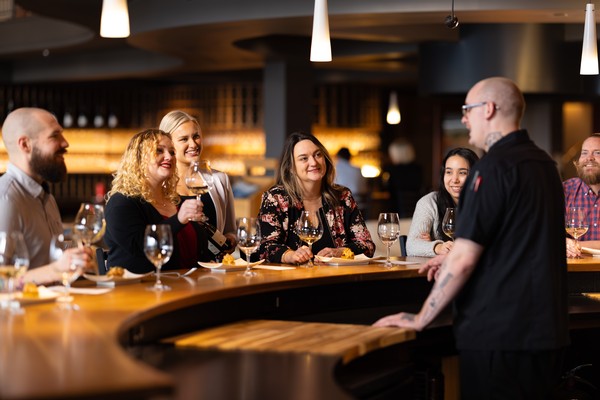
The Chef's Counter communal experience seats eight guests.
Attendees can also engage with other wine enthusiasts at the eight-person counter nestled in the Estate Tasting Room as they enjoy a four-course small-bites menu. Current pairings include seasonal seafood with elevated wines and a Bananas Foster dessert paired with 2019 Domaine Willamette Brut. Please note substitutions and modifications may not be available.
Reservations are $60 per person or $45 for Owners and Club Members. The Chef’s Counter experience is available Monday through Friday at 2 pm and lasts around an hour and a half.
Your ticket cost will be credited to a 4-bottle purchase of featured wines or a 6-bottle purchase per couple.
What to expect
Chef Jarred said he’s excited for guests to try the unique pairings. The winter menu features Dungeness crab, halibut and more, paired with a mix of bold and lighter wines. The menu will change seasonally.
“I wanted to focus on textures and play on different temperatures of food and wines to create an intriguing movement on the palate,” he said.
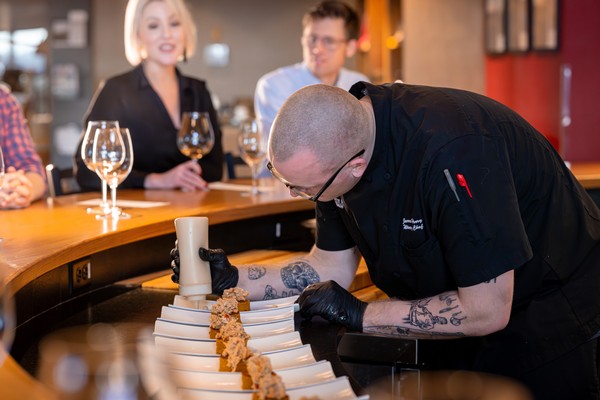
Winery Chef Jarred Henry puts the finishing touches on dishes at the Chef's Counter.
The Chef’s Counter will offer an intimate setting for guests to learn more about the food and wine they’re enjoying.
A Winery Ambassador will guide attendees through the tasting experience and share stories about the featured wines. Guests will also have a passport to fill out tasting notes.
“We were looking for a really fun, energetic and engaging experience for our guests to interact with the Chef and Winery Ambassador,” Hospitality & Guest Experience Manager Kaylin Ray said. “It’s intended to spark conversation. I’m excited about the liveliness and energy it’ll bring to the Tasting Room.”
A lasting impact
The Chef’s Counter experience is more than just a tasting — it’s an educational opportunity too. Guests can take what they learn at Willamette with them to their next party or dinner.
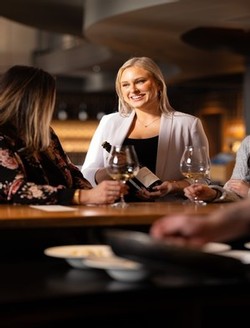
“We’re going to walk guests through the pairings and they’ll be able to take that knowledge with them as they pair wines with special dishes at home,” Kaylin said.
The Chef’s Counter is approachable, she added. It’s perfect for both new and experienced wine enthusiasts.
With seasonal and local ingredients at the forefront, guests can also learn how our terroir influences both the dishes and wine.
“You’re not going to get this one-on-one experience anywhere else in the Willamette Valley right now,” Kaylin said. “It’s an opportunity to talk to the Chef, make friends, socialize and learn from top-tier ambassadors.”
Wishing You a Happy New Year
2023 | Year in Review
Thank you for your continued support of Willamette Valley Vineyards throughout 2023. Your steadfast commitment to Willamette allows us to tell the Oregon story through sustainably grown and crafted wine.
Exciting growth, strides in sustainability and a plentiful harvest filled the winery's 2023 calendar. Please read more about some of the year's highlights below.
We wish you and yours a joyful 2024.
January | Red-Tailed Hawk released
Cascade Raptor Center (one of our partners in sustainability) rescued an injured red-tailed hawk from Interstate 5 on Christmas Day 2022 and released her at the Estate in the Salem Hills after her rehabilitation. The hawk is named “Jory” after the red Jory soil at the vineyard and the hawk's tail color. Club Members have since spotted her flying past the Willamette Room.
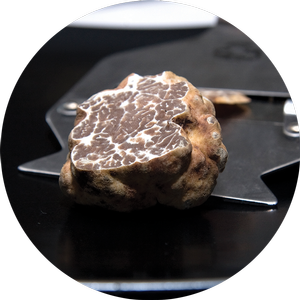
February | Domaine Willamette Truffle Dinner
As a part of our ongoing partnership with the Oregon Truffle Festival, we hosted a Truffles & Bubbles Sparkling Dinner at Domaine Willamette. Attendees enjoyed the state's best truffles with our award-winning sparkling wines. In 2024, wine enthusiasts will enjoy a truffle dinner on Saturday, February 24th or Sunday, February 25th at the Estate in the Salem Hills.
March | Women in Wine Celebration
To celebrate Women's History Month and the contributions of Elton Vineyard Founder Betty O'Brien, we hosted multiple Women in Wine pairing dinners in her honor. Guests enjoyed a Cookies & Wine Pairings Guide in March as a nod to Betty's former work as Executive Director of the Santiam Girl Scouts. Betty celebrated her 80th birthday and Elton celebrated its 40th anniversary in 2023.
April | Tirage bottling for our 2022 Brut
Our 2022 Domaine Willamette Méthode Traditionnelle Brut went into tirage, a critical step in making sparkling wine. Tirage is a secondary fermentation where the base wine is combined in the bottle with sweet dosage and yeast and sealed with a crown cap to create pressure and bubbles. After aging for 30 months on their lees, the bottles are disgorged and enclosed with their traditional corks and wire cages.
May | Oregon Wine Month
In honor of Oregon Wine Month, we recognized the Oregon Wine Pioneers who have helped make Willamette what it is today. This included Founder and CEO Jim Bernau, Elton Vineyard Founders Dick and Betty O'Brien and Tualatin Estate Vineyard Founder Bill Fuller. We also honored Traute Moore (pictured), a founder of Quail Run Vineyards who passed away this year. The fruit for our Griffin Creek wines is grown at Quail Run Vineyards in Southern Oregon's Rogue Valley. Now, Traute's son Michael manages the vineyard.
June | Jory Claim Planting
Our vineyard team planted the new Jory Claim Vineyard with Pinot Noir vines this year. The vineyard is located near the Estate in the Salem Hills and is visible from the tasting room. The vineyard will be LIVE (Low Input Viticulture & Enology) and Salmon-Safe certified like the rest of our estate vineyards.
The site was part of the Jory Family's original homestead, pioneered in 1848 after the family came west on the Oregon Trail. Jory is also the name of Oregon's State Soil, known for providing the exceptional drainage that helps grow high-quality Pinot Noir grapes and produce lush wines of bright red fruit and subtle minerality.
June | 2022 Whole Cluster Rosé of Pinot Noir awarded 94 points
The 2022 Whole Cluster Rosé of Pinot Noir was awarded 94 points and a gold medal at the 2023 Sunset International Wine Competition. Judges remarked on the wine's outstanding color, floral bouquet and honeysuckle notes.
July | Willamette's 40th Anniversary
Willamette stockholders celebrated the winery's 40th Anniversary during our annual Owners Weekend and Shareholder Meeting. The festivities included pairing dinners, tours and a historic group photo of our wonderful Owners at Domaine Willamette.
July | Biodynamic clock unveiled at Domaine Willamette
The biodynamic clock at Domaine Willamette is a working clock that reflects favorable agricultural activity based on the phases of the moon. The clock – located in the Wine Shop at Domaine Willamette – serves as an interpretive element for the biodynamically-farmed Bernau Estate Vineyard. This year, Bernau Estate Vineyard officially earned the Demeter Biodynamic Certification.
July | Domaine Willamette received the Landmark Award
Portland Business Journal honored Domaine Willamette with its Landmark Award and recognized the uniqueness of the winery’s design and its contribution to its community. Wine Enthusiast Magazine also honored Domaine Willamette, listing the sparkling winery as one of eight must-visit wineries in the Willamette Valley AVA.
August | Vancouver Tasting Room & Restaurant opened its Red Blending Experience
The Vancouver Tasting Room & Restaurant opened a Red Blending Experience featuring five bold Walla Walla varietals. Using a unique system invented for Willamette Wineworks in Folsom, California, and modified by Research & Development Manager David Markel, the Blending Systems can be found at Willamette Wineworks, the Estate in the Salem Hills and on the Vancouver Waterfront.
August | 50th Anniversary of Tualatin Estate Vineyard
Established in 1973 by Bill Fuller and his business partner Bill Malkmus, Tualatin Estate Vineyard is one of Oregon’s oldest and most respected vineyard sites. In 2023, Bill Fuller celebrated the 50th anniversary of Tualatin Estate Vineyard, the release of his Vintage 48 Pinot Noir and Chardonnay and his 86th birthday.
September | Stock Offering sold out
Willamette's summer stock offering was oversubscribed, surpassing its funding goal ahead of schedule. Initially aiming to raise $3.53 million by the end of the year, the winery exceeded expectations, receiving applications for around $4.34 million before October 1st.
October | Harvest
Founder and CEO Jim Bernau celebrated the 2023 harvest with a virtual toast with our vineyard and winemaking team, Owners and Club Members. Harvest started at Bernau Estate Vineyard with picks of Pinot Noir, Pinot Meunier and Chardonnay that will be used in our sparkling wines. The first picks of Pinot Noir for still wines started a week later. The Bernau Estate Vineyard in the Dundee Hills is ideal for growing grapes for sparkling wine due to the fruit developing aroma and flavor at earlier levels of maturity. This allows for high levels of flavor and low levels of ripeness in the grapes, which is the perfect combination for sparkling wine.
November | Cow horn burial
Vineyard stewards, staff and Owner volunteers gathered at Domaine Willamette to bury a cache of cow horns filled with manure as a part of the biodynamic farming practices followed at Bernau Estate Vineyard. Come spring, the manure will be a rich, dark, earthy matter used in sprays to deliver nutrients to the ground under the vines.
November | Efren Loeza honored by ¡Salud!
Vineyard Manager Efren Loeza was honored at the ¡Salud! Auction for his many years of work with the organization. Efren has become an advocate for ¡Salud!, connecting vineyard workers to vital services and caring for the next generation of vineyard steward leaders.
November | Mason bee box cleaning
Stephen Paisley, Willamette’s “Bee Guy,” and Facilities Coordinator Randy Hillyer removed nearly 11,000 cocoons during the annual mason bee box cleaning. These bees play a crucial role in encouraging biodiversity and maintaining a healthy bee population since they are some of the most efficient pollinators. Mason bees are easy for our crew to handle since they don't produce honey.
December | Two wines won gold at invitation-only global contest
The 2019 Domaine Willamette Méthode Traditionnelle Brut and the 2019 Griffin Creek Cabernet Franc won gold at the Global Fine Wine Challenge. The contest includes wines from Australia, Canada, New Zealand, South Africa and the United States.
December | Bend Tasting Room & Restaurant opened
Thanks to the support of our Owners, we opened a new Tasting Room & Restaurant in downtown Bend featuring cozy fireplaces and our signature barrel booth seating. Guests can now enjoy the Willamette experience in Central Oregon.
Mo’s Seafood & Chowder Festival Returns to Willamette Valley Vineyards
Mo’s Seafood & Chowder Festival is making a triumphant return to Willamette Valley Vineyards this January.
Willamette hasn’t hosted the classic event since 2020, and wine enthusiasts and crab lovers alike have felt its absence.
“With the three-year hiatus, we’ve missed out on people visiting from out of town who would come annually,” Estate General Manager Spence Fogarty said. “For many local Club Members, this has been one of the most sought-after events we host. It's a staple in January.”
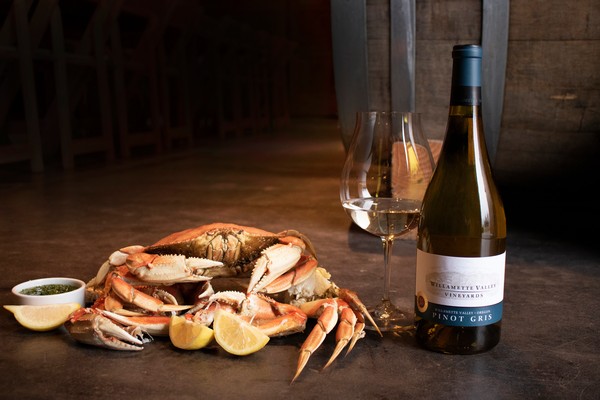
Fresh crab pairs perfectly with Willamette's Pinot Gris.
The festival returns to our Estate in the Salem Hills on January 26th-28th. Seafood and wine will take center stage as attendees delight in delicious chowder bowls and other fresh seafood paired with our classic Oregon wines, including the 2022 Pinot Gris.
Tickets are available for purchase online. Admission is $40 per person or $30 for Club Members and Owners. Tickets include a glass of wine, a $15 wine credit, a Riedel glass to take home, live music and access to the event. A variety of Mo’s seafood and sides will be available for purchase.
“We created this event many years ago as a partnership with another local Oregon brand,” Spence said. “The event brings the amazing offerings of the coast to the Willamette Valley for us to share that story with our customers and guests.”
Mo’s North Coast Regional Manager Billie Jo Edmonds said her heart was filled with joy when she learned the event was coming back in 2024.
“My favorite part is the interaction we get with everyone,” Billie Jo said. “We bring in such a diverse group of individuals who make the event so fun.”
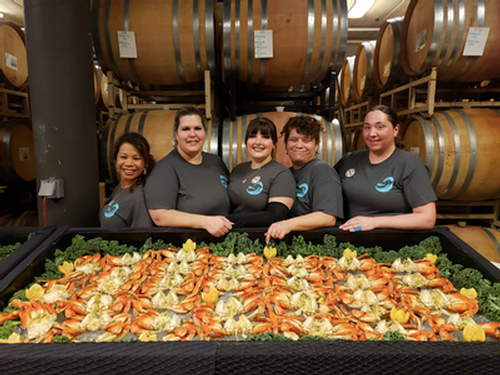
The Seafood and Chowder Festival is Mo's biggest event of the year.
What to expect
This year’s festival is the 24th iteration of the event. As usual, Louie, the giant inflatable crab, will tower over the Estate and be a great photo-op for attendees. This family-friendly event has something for everyone.
“If you’ve never been, you don’t know what you're missing,” Billie Jo said.
Mo’s will prepare food for purchase like shrimp skewers, clam chowder, oyster shooters and a crab dinner. Guests who purchase a case of wine will receive a whole crab to enjoy at the festival too.
With the Oregon crab season opening just last week, the seafood should be particularly tasty this year.
“It looks like it's going to be a really good season,” Billie Jo said. “I’m expecting big, fat, juicy crabs this year.”
Louie the inflatable crab is a great place for kids and adults alike to take photos.
The festival is the perfect opportunity to celebrate the bounty that Oregon provides from both the ocean and the land as it highlights wonderful seafood and wine pairings. While Pinot Gris is at the forefront, many of our wines — both white and red — can complement fresh seafood.
Although the pandemic put a hold on the popular event, Spence said it’s expected to return with a full crowd.
“We look forward to celebrating this event for many years to come,” he said.
